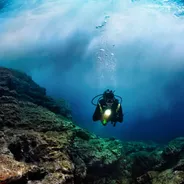Somewhere between a meme, a challenge and a character, Momo is an elusive figure. The image of her gaunt face has, according to multiple reports, been used in threatening clips hidden inside children's content on YouTube. However, despite warnings from the police, YouTube has told VT that they have no evidence to suggest that this is anything more than a hoax.
"Contrary to press reports, we have not received any evidence of videos showing or promoting the Momo challenge on YouTube," a spokesperson stated. "Content of this kind would be in violation of our policies and removed immediately."
Nonetheless, police have warned that cybercriminals are using her haunting image in order to either manipulate users into giving up personal information or to convince young children to harm themselves or others.
Momo is akin to Slenderman and other incarnations of internet folklore, yet is thought to pose a very real danger to those who are easily led. The content reportedly affected includes Peppa Pig or Fortnite videos which are then interrupted by an image of Momo with a set of threats and demands. The figure has also been known to appear on messaging platforms such as WhatsApp.
“Even basic open source research suggests that 'Momo' is run by hackers who are looking for personal info,” said police in Craigavon, Northern Ireland, via a Facebook post. “Whatever or whoever is behind it, there is no disputing the content being sent is horrendous. The set up can come from countless other apps- anything with a chat function. A 'curse contact' sends a number and tells you to contact them on Whatsapp. One video of such interaction in America I've seen shows an ominous sounding voice recording being sent to a child telling them to take a knife to their own throat. Another threatens family if a 'challenge' is not completed. It's chilling viewing. There are numerous variations and of course now imitators.”
To find out how parents can protect their children from dangers on the internet, VT spoke to Alastair Graham - CEO of AgeChecked, a provider of online solutions to retailers of age-restricted goods and services. “Parents could start to make themselves familiar with potential online threats before teaching their children about where dangers may lie,” he explains. “There are a number of online resources that can help with this. The NSPCC runs free online training courses and a helpline to advise parents on how to keep their children safe and monitor what they are accessing online. Additionally, there is lots of helpful advice on offer from public service websites such as GetSafeOnline.”
“Apple’s Screen Time provides parents with tracking on all the apps that children use across all iOS devices,” Graham adds. “Parents can receive detailed activity reports on each app and time restrictions can be set to curb time spent on them. This also provides web filtering, age restriction and app blocking capability. Google’s Digital Wellbeing app also includes a pie chart showing parents how a phone is used, an app timer to limit the time spent on them and a ‘wind down’ feature which works by shifting the phone screen to greyscale at a specified time. This is in addition to Family Link which helps parents control their children’s use of Android.”
The aforementioned Facebook post by Craigavon PSNI (Police Service of Northern Ireland) also points the finger of blame at the media’s reporting on the subject. It states that: “headlines like ‘Suicide game hits UK’, [get] people clicking like mad on articles to read more.” The post adds: “Great for a short term shock effect, but not great long term as it somewhat misses the bigger issue.”
However, the police department themselves have come under fire for adding fuel to the fire. “Many of the ‘police warnings’ in question refer to a Facebook post on the Craigavon PSNI page, which states unverified information as fact,” says Peter Donaghy on the blog Slugger O’Toole.
Donaghy argues that the police department’s Facebook post caused a spike in interest in the subject, with news outlets such as the BBC and the Independent subsequently writing about Momo. However, the post doesn't highlight a direct causal link.
“Last week, 2 days before the PSNI issued this, I saw an article about this phenomenon on Belfast Live,” a commenter writes on the blog post. “I then asked my 9 year old daughter did she know what MOMO was, without me knowing anything about it, and she went into hysterics. She said she had been having nightmares about it for weeks as it was popping up in the middle of her YouTube videos on mine craft. Granted the hysteria may have heightened as a result of the PSNI post, but they certainly didn’t create it.”
Momo’s image comes courtesy of Japanese special effects company Link Factory. Her bird feet add a certain sense of surrealism which borders on the ridiculous (which is perhaps why they are cut off of most photos). The image’s internet presence can be traced back to August 2016 but it was only when it was added to the Reddit thread r/creepy that its popularity soared. Last year, similar stories of scares broke when the image was reportedly being used to scare or exploit people. A Telegraph article goes into further detail on Momo’s origins.
This week, many news outlets have claimed that the Momo phenomenon has been linked to 130 suicides of teens in Russia. Ironically, this confusion may have arisen from a 2018 Washington Post feature which aimed to debunk myths around the Momo phenomenon - as it also mentioned that the “Blue Whale Challenge” was reportedly linked to 130 deaths in Russia.
Parents remain concerned and online commenters testify that the clips are being hidden in content aimed at children. Increasingly, pressure is being put on these platforms to tighten controls. “Incoming regulation under the Digital Economy Act, which requires the use of age-gates on adult content websites, is a step in the right direction,” AgeChecked's Alasdair Graham explains. “However, we have a moral obligation to do more. There is no reason why this approach cannot be replicated across all websites that can expose children to harmful material.”
“There is a natural tendency to shield children from issues that might cause distress,” he continues, “but unfortunately in some cases youngsters will inevitably come into contact with harmful content such as Momo. Therefore, it is advisable to give children the information they need to be safe, whilst helping them to understand the importance of creating boundaries for themselves.”
“To achieve this,” he adds, “parents could discuss these dangers with their children as soon as they become aware of them. In doing so, youngsters will be more equipped and empowered to identify this sort of content as dangerous and ultimately avoid it.”
A Snopes article discusses the suicide of a girl in Argentina which, due to media reporting, is now widely considered to have been linked to the Momo phenomenon. “Authorities in Argentina never did confirm that the girl’s suicide was encouraged by her participation in a viral ‘game’,” the article states, “rather than a real-life person.”
This perhaps highlights the inherent problem with referring to the phenomenon as a "game" or a "challenge". In reality, there is always a real person behind the image. Other suicides discussed in conjunction with Momo are also missing a direct link though, considering the circumstances, this may be difficult to find.
Momo isn’t actually real and, in this sense, is inherently a hoax. Nonetheless, what YouTube have said on the subject is directly contradicting what parents are reporting. Furthermore, use of the image on WhatsApp seems more likely. However, questionable online accounts such as that by YouTuber AldosWorld TV cast further doubt on this.
Whether or not hysteria has overtaken the problem of Momo itself - if indeed there is a problem - is difficult to say. As with many phenomenons born on the internet, Momo remains relevant thanks to a degree of mystery.
If you have been affected by any of the issues in this article, contact Your Life Your Voice on 1 800 448 3000, Samaritans on 116 123 or the National Suicide Prevention Hotline on 1 800 273 8255. For recorded information, call Mind on 0300 123 3393












